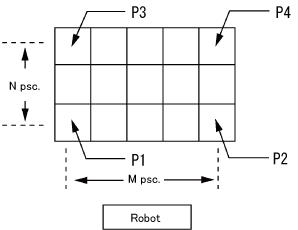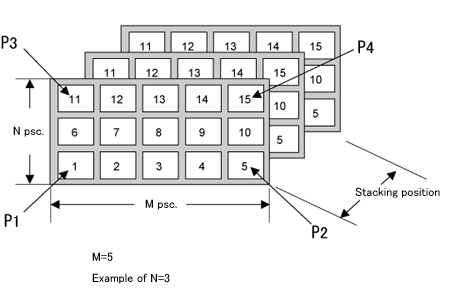ID : 3634
Pallet.CalcPos
Function
Specify the pallet conditions, stack count and the target position number to retrieve the desired position.
Syntax
Pallet.CalcPos(P1_P3 divisions,P1_P2 divisions,Height of one stack,pallet 4-corner position P1,pallet 4-corner position P2,pallet 4-corner position P3,pallet 4-corner position P4,pallet target position number[, Stack count][, Robot Number])
Guaranteed Entry

- P1_P3 divisions
- Specify the number of divisions on the P1-P3 direction (N) by integer type data.
- P1_P2 divisions
- Specify the number of divisions on the P1-P2 direction (M) by integer type data.
- Height of one stack
- Specify the height of one stack by single precision real number type data. The position of the height of pallet is calculated by [Height of one stack]*([Stack count]-1). If pallets are piled up successively, enter a positive value.
If pallets successively diminish in number, enter a negative value.
When you use the [Stack count] with 1 always, this value is not available. Enter 0. - Pallet 4-corner position P1
- Specify the first position in the four corners by position type data.
- Pallet 4-corner position P2
- Specify the second position in the four corners by position type data.
- Pallet 4-corner position P3
- Specify the third position in the four corners by position type data.
- Pallet 4-corner position P4
- Specify the fourth position in the four corners by position type data.
- Pallet target position number
- Specify the target position number that is counted from the first position of the stack by integer type data.
- Stack count
- Specify the stack count from the first stack by integer type data.
This should be "1" if this is omitted. - Robot Number
-
Specify "0" for this entry.
This entry is omittable. This should be "0" if this is omitted.
Return Value
Return a target position by position type data.
Description
Specify the pallet conditions, stack count and the target position number to retrieve the desired position.
Pallet conditions to specify are; P1-P3 division (N), P1-P2 division (M), stack height, and pallet four corners (P1 to P4).
Pallet position numbers are assigned from P1 to P2 and after P2, subsequent numbers are assigned from P1 plus 1 to P3 horizontally as indicated in the figure.

Related Terms
-
Attention
-
Example
'!TITLE "Acquiring Coordinate Position of Pallet Target Position Number"
' Acquire coordinate position designated by pallet target position number and display it on
the message output window
Sub Sample_PalletCalcPos
Dim aaa As Position
Dim bbb As Position
Dim ccc As Position
Dim ddd As Position
Dim eee As Position
Dim fff As Position
Dim ggg As Position
' Assign position indicating pallet four corner position P1 to aaa
aaa = P( 300, -100, 50, -180, 0, 180, 5 )
' Assign position indicating pallet four corner position P2 to bbb
bbb = P( 300, 100, 50, -180, 0, 180, 5 )
' Assign position indicating pallet four corner position P3 to ccc
ccc = P( 100, -100, 50, -180, 0, 180, 5 )
' Assign position indicating pallet four corner position P4 to ddd
ddd = P( 100, 100, 50, -180, 0, 180, 5 )
' Assign coordinate position of pallet target position number 1 to eee
eee = Pallet.CalcPos( 3, 5, 20, aaa, bbb, ccc, ddd, 1, 1 )
' Display coordinate position of pallet target position number 1 on the message output window
PrintDbg eee
' Assign coordinate position of pallet target position number 8 to fff
fff = Pallet.CalcPos( 3, 5, 20, aaa, bbb, ccc, ddd, 8, 1 )
' Display coordinate position of pallet target position number 8 on the message output window
PrintDbg fff
' Assign coordinate position of pallet target position number 15 to ggg
ggg = Pallet.CalcPos( 3, 5, 20, aaa, bbb, ccc, ddd, 15, 1 )
' Display coordinate position of pallet target position number 15 on the message output window
PrintDbg ggg
End SubID : 3634

